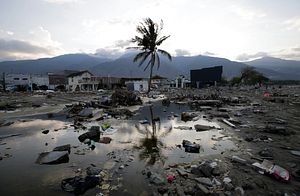On September 28, a 7.5 earthquake in Central Sulawesi, Indonesia, triggered a localized tsunami which crashed up the long, narrow bay at the mouth of the Palu river. Palu, a city of more than 330,000, suffered horrific damage as a wave estimated to have risen to 5 meters (16.4 feet) smashed into the city. Indonesian authorities estimate that more than 66,000 homes have been destroyed or damaged by the double disaster.
As of October 4, the death toll had risen to 1,424. Many have been buried in mass graves. Thousands have been injured and possibly hundreds of thousands displaced. Authorities are reportedly focusing rescue efforts on Palu, though other communities along the tsunami’s pathway have been devastated, as have those further up the mountainous terrain, which were hit hardest by the earthquakes and ensuing mudslides.
With authorities setting a tentative deadline of Friday for rescue efforts, hopes for finding more people alive are dwindling. Among the living, desperation is setting in, with food and water shortages sparking looting and subsequent threats from Indonesia military authorities that looters will be shot.
Further highlighting the region’s seismic and significant vulnerabilities, on October 3, Mount Soputan in northern Sulawesi erupted, sending an ominous smoke plume four kilometers into the sky.











































